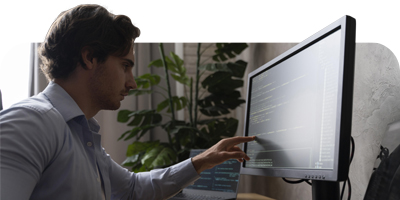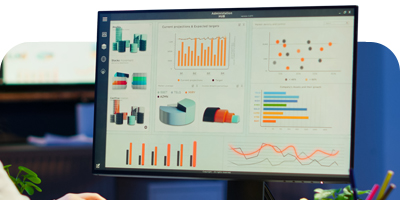RPA
Robotic Process Automation is the technology that allows software to be used to mimic most of the actions of a user at their workstation. Robots use the user interface to capture data and manipulate applications as users do themselves.
Cognitive technology
& Artificial Inteligence
RPA is not an intrusive technology, but adapts to existing environments and systems and coexists with them as any other user does, only, in this case, a virtual one. The RPA evolution is focused on the incorporation of capabilities based on cognitive technology and Artificial Intelligence.
RPA is already one of the main channels for introducing Artificial Intelligence in companies. Finally, robots interpret, trigger responses and communicate with other systems to perform a wide variety of repetitive tasks with a difference: a software robot can operate for 24 hours uninterruptedly and makes zero mistakes.
RPA
RPA is not an intrusive technology, but adapts to existing environments and systems and coexists with them as any other user does, only, in this case, a virtual one. The RPA evolution is focused on the incorporation of capabilities based on cognitive technology and Artificial Intelligence.
RPA is already one of the main channels for introducing Artificial Intelligence in companies. Finally, robots interpret, trigger responses and communicate with other systems to perform a wide variety of repetitive tasks with a difference: a software robot can operate for 24 hours uninterruptedly and makes zero mistakes.
Cognitive automation
Cognitive automation creates jobs where robots and people complement and enhance each other’s capabilities. It is a new and advanced conception of work on the road to hyper-automation.
Cognitive automation takes artificial intelligence into the everyday workplace, performing tasks that until recently software could not do: learning, finding complex patterns in millions of pieces of data, extracting information from unstructured texts, detecting feelings…
By combining and integrating RPA with other technologies such as character recognition (OCR), machine learning (ML), natural language processing (NLP), image or video analysis thanks to artificial intelligence and data analysis, we can automate complex processes while monitoring results and ROI.
RPA, IA and intelligent document processing
The combination of RPA and AI allows robots to understand the most varied types of invoices, classify and extract data from PDFs, contracts, public deeds, articles…
Process Mining
Process Mining is a BPM technique that generates, from data analysis, a graphical definition of the real process, as it is carried out, and compares it with the theoretical one. The analysis of system logs (ERP, CRM…) makes it possible to automatically identify and model processes and to see how users interact with the systems.
These processes can be optimised by eliminating bottlenecks, redundancies or by establishing, for example, more efficient workflows.
Finally, Process Mining tools generate RPA scripts that simplify and accelerate the construction of new robots.
From Back office to Front office
Most current robotization projects automate internal company or back office processes. However, AI capabilities can improve the user experience, detect moods, predict behaviour, etc. All of these functions are very useful for improving front office systems.
Benefits of the RPA
A robotization project pays for itself in a few months and creates competitive advantages, those brought by the virtual workforce.
A robot can be designed and implemented in a few days or weeks, depending on the complexity of the process and the rules that govern it. Robotize is a perfect example of applying Agile methodology. The benefits are quickly realised, with savings and investment under control at all times.
· Increases the productivity of work teams by incorporating a virtual workforce.
· It suppresses the performance of non-value-added activities.
· Control the execution of processes through monitoring utilities.
· Eliminates mistakes by ensuring compliance with standards, regulations, service commitments…
· Improves and extends the life of existing information systems by eliminating operational and functional gaps.
· It creates efficient jobs, focused on expanding and improving the use of human capacity.
Benefits of the RPA
A robotization project pays for itself in a few months and creates competitive advantages, those brought by the virtual workforce.
A robot can be designed and implemented in a few days or weeks, depending on the complexity of the process and the rules that govern it. Robotize is a perfect example of applying Agile methodology. The benefits are quickly realised, with savings and investment under control at all times.
· Increases the productivity of work teams by incorporating a virtual workforce.
· It suppresses the performance of non-value-added activities.
· Control the execution of processes through monitoring utilities.
· Eliminates mistakes by ensuring compliance with standards, regulations, service commitments…
· Improves and extends the life of existing information systems by eliminating operational and functional gaps.
· It creates efficient jobs, focused on expanding and improving the use of human capacity.
Service model
When the project is ambitious and involves an important part of the company, Devol designs and defines the internal structure necessary to govern the robotization.
Process engineering
To analyze, identify and prioritize automatable processes. This identification is done following a multi-criteria scoring or valuation scheme. In addition, an individualized business case is made to justify each robot.
RPA Delivery
Design, development, testing and implementation of software robots that will help optimize your organization’s workflow.
RPA Maintenance
It monitors the operation of the installed robot fleet and makes evolutionary improvements derived from changes in the environment, in the process… or wherever a need arises.



Proprietary methodology and technical assets
At Devol we have developed our own methodology, “RPA Journey” and our own RPA development framework, “Devol Framework” that contains everything necessary to guarantee robotization success.
Devol Framework
Devol has its own development framework that provides speed and standardization of programming, incorporates functions that strengthen the robot’s behavior and simplifies the robot’s coexistence with users and the IT department.
RPA Journey
It contains the methods, procedures, forms… applicable to each of the stages and activities of a robotization project. The practical application of “RPA Journey” guarantees the correct analysis of processes, effective communication with users, the necessary documentation for subsequent maintenance, the management of tests and production environments… In short, the quality of the service and deliverables.

Proprietary methodology and technical assets
At Devol we have developed our own methodology, “RPA Journey” and our own RPA development framework, “Devol Framework” that contains everything necessary to guarantee robotization success.
Devol Framework
Devol has its own development framework that provides speed and standardization of programming, incorporates functions that strengthen the robot’s behavior and simplifies the robot’s coexistence with users and the IT department.
RPA Journey
It contains the methods, procedures, forms… applicable to each of the stages and activities of a robotization project. The practical application of “RPA Journey” guarantees the correct analysis of processes, effective communication with users, the necessary documentation for subsequent maintenance, the management of tests and production environments… In short, the quality of the service and deliverables.
